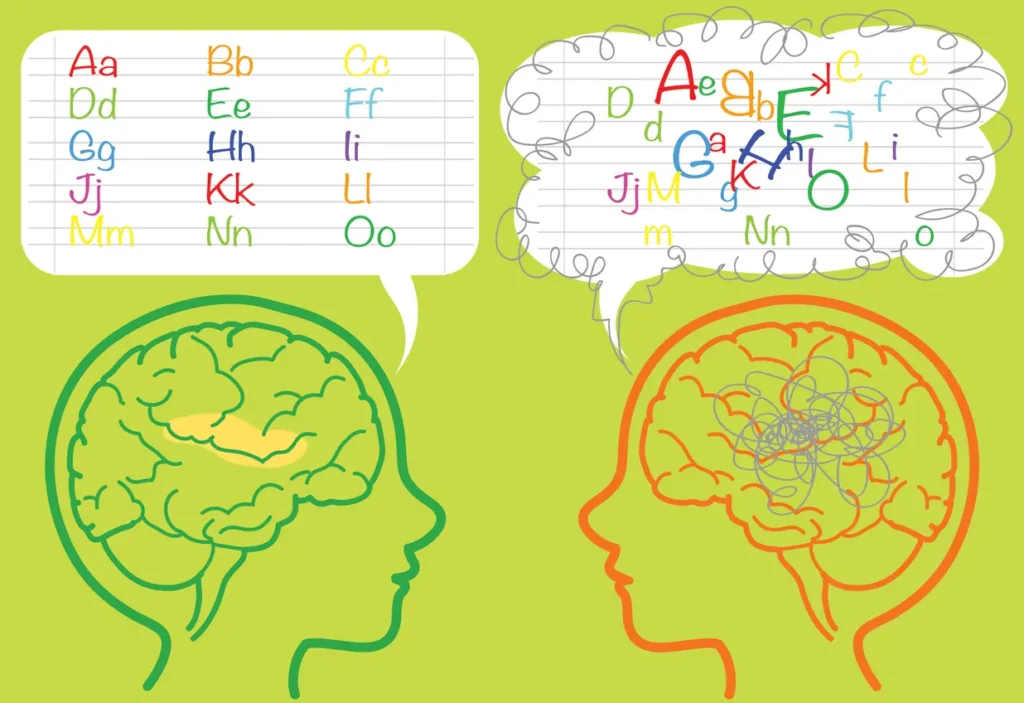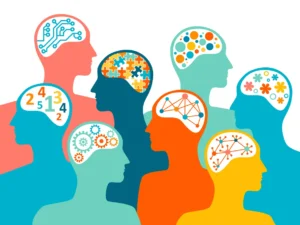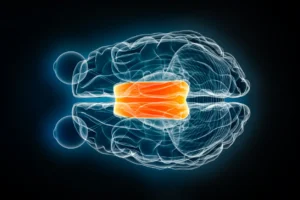
Story at-a-glance
- Comorbidity is the rule, not the exception – Most children with learning disabilities have more than one condition, with studies showing 40-60% of children with one learning difference also having another, creating complex learning profiles.
- Shared underlying brain systems create overlap – Many learning disabilities affect similar neural pathways and brain regions, particularly those involved in language processing, attention, and executive function, leading to frequent co-occurrence.
- Recognition requires comprehensive evaluation – Identifying multiple learning disabilities can be challenging because symptoms may overlap, mask each other, or be attributed to a single condition when multiple factors are actually at play.
- Integrated support addresses the whole child – Understanding how different learning challenges interact allows for more effective interventions that address the complete learning profile rather than treating each condition in isolation.
When parents first learn their child has a learning disability, they often hope this single diagnosis will explain all their child’s academic and behavioral challenges. But the reality is more complex: most children with learning disabilities don’t have just one condition. Instead, they have multiple learning differences that interact with each other in ways that can amplify challenges, create unexpected strengths, or produce entirely new patterns of learning needs.
This overlap of learning disabilities – called comorbidity in clinical terms – is actually more common than having just one isolated learning difference. Research consistently shows that children with one learning disability have a much higher likelihood of having additional learning challenges than children in the general population. Understanding this overlap is crucial for getting your child the comprehensive support they need.
The interconnected nature of overlapping learning disabilities makes sense when you consider how the brain works. Learning involves complex networks of brain regions working together, and when one system is affected, it often impacts related systems. This means that addressing your child’s learning needs requires understanding not just individual conditions, but how they interact and influence each other in your child’s unique learning profile.
Understanding Overlapping Learning Disabilities
The Statistics Tell the Story
Research reveals striking patterns of overlap among learning disabilities. Children with dyslexia have a 25-40% chance of also having ADHD, while children with ADHD have a 15-40% chance of having dyslexia. Approximately 60% of children with dyslexia also have difficulties with math, and 43% of children with math disabilities also have reading difficulties.
These aren’t coincidences – they reflect the interconnected nature of learning systems in the brain. The same neural networks that support reading often contribute to mathematical thinking, attention regulation, and executive functioning. When these networks develop differently, the effects can ripple across multiple areas of learning.
The prevalence of multiple learning disabilities means that comprehensive evaluation and support planning should always consider the possibility of additional conditions, even when one diagnosis seems to explain most of a child’s challenges.
Shared Neurological Foundations
Many learning disabilities share common underlying neurological factors. The brain regions responsible for phonological processing (critical for reading) overlap significantly with areas involved in mathematical reasoning, working memory, and attention regulation. This shared neural real estate helps explain why difficulties in one area often coincide with challenges in others.
Executive function systems, which control attention, working memory, and cognitive flexibility, support learning across all academic domains. When these systems function differently, the effects appear in multiple areas simultaneously, creating patterns of strengths and challenges that span various learning disabilities.
Language processing systems also underlie many different learning functions. Since language is involved in reading, writing, mathematical word problems, social communication, and following instructions, differences in language processing can manifest as multiple, seemingly unrelated learning challenges.
Common Combinations and Their Manifestations
Dyslexia and ADHD: The Attention-Reading Connection
The combination of dyslexia and ADHD is one of the most common overlaps in learning disabilities. Children with both conditions face unique challenges because their reading difficulties are compounded by attention and focus issues, while their ADHD symptoms can be exacerbated by the frustration of struggling with text.
These children might hyperfocus on preferred reading materials while being unable to sustain attention for required academic reading. They might understand complex concepts when information is presented orally but struggle to extract the same information from written text due to the combined impact of decoding difficulties and attention challenges.
The combination can also create executive function challenges that affect both reading and attention. Difficulties with working memory might impact both the ability to hold phonological information while decoding words and the ability to follow multi-step instructions or complete complex tasks.
Dyslexia and Dyscalculia: Language Meets Math
Mathematics involves significant language processing, particularly in word problems, mathematical vocabulary, and the sequential processing required for multi-step calculations. Children with both dyslexia and dyscalculia often struggle with the language demands of mathematics while also having difficulties with numerical concepts and calculations.
These children might understand mathematical concepts when demonstrated visually or through hands-on activities but struggle when the same concepts are presented through written problems or verbal explanations. They might excel at geometry or spatial mathematical concepts while struggling with arithmetic that requires language processing.
The combination can also affect mathematical reasoning because many mathematical concepts are initially learned through language-based instruction. When both language processing and numerical processing are affected, mathematical learning becomes particularly challenging.
ADHD and Executive Function Disorders: The Control Center Struggles
ADHD and executive function disorders share so much overlap that some experts consider them part of the same spectrum of challenges. Both involve difficulties with the brain’s management and control systems, affecting attention, planning, organization, time management, and impulse control.
Children with both conditions often experience amplified challenges in academic settings that require sustained attention, long-term planning, and organized approach to learning. They might struggle to initiate tasks, sustain effort through completion, and organize materials and time effectively.
The combination can create cascading effects where attention difficulties make organization harder, while organizational challenges increase attention demands, creating a cycle of academic and behavioral struggles.
Autism Spectrum Differences and Learning Disabilities
Many children on the autism spectrum also have co-occurring learning disabilities. The combination might involve autism characteristics like intense interests, sensory sensitivities, and social communication differences alongside dyslexia, ADHD, or other specific learning challenges.
These children often have uneven learning profiles where they excel in areas of interest while struggling significantly in other academic domains. Their autism characteristics might mask learning disabilities, or learning disabilities might be misattributed to autism when they’re actually separate, co-occurring conditions.
The interaction between autism and learning disabilities can create unique educational needs that require specialized understanding of both conditions and how they influence each other.
Sensory Processing and Learning Disabilities
Sensory processing differences frequently co-occur with various learning disabilities. Children might have dyslexia along with auditory processing challenges, or ADHD combined with tactile sensitivities that affect their ability to engage with typical learning materials.
These sensory differences can significantly impact how children access and process educational information. A child with both dyslexia and visual processing challenges might struggle not only with decoding text but also with visual tracking, spatial organization of information on pages, and visual attention to relevant details.
The combination requires careful consideration of how sensory needs interact with learning challenges to create comprehensive support plans that address both areas.
How Overlapping Conditions Interact
Compounding Effects
When multiple learning disabilities occur together, their effects often compound rather than simply add together. A child with both ADHD and dyslexia doesn’t just face the challenges of each condition separately – the combination creates new challenges that are greater than the sum of their parts.
For example, the working memory challenges associated with both conditions can severely impact reading comprehension because the child must simultaneously decode words, hold information in memory, and make connections between ideas. Each task is difficult individually, but together they can overwhelm the child’s cognitive resources.
Similarly, executive function challenges from ADHD can make it much harder to apply reading strategies learned to address dyslexia, while reading difficulties can increase frustration and reduce motivation, worsening ADHD symptoms.
Masking Effects
Sometimes one learning disability can mask the presence of another, making comprehensive identification challenging. A child with significant ADHD symptoms might have their reading difficulties attributed to attention problems rather than recognizing underlying dyslexia that requires different interventions.
Conversely, a child who has developed strong compensatory strategies for dyslexia might not show obvious reading difficulties, making it harder to recognize that their attention and executive function challenges stem from the cognitive effort required to manage their hidden reading struggles.
These masking effects can delay appropriate intervention and support, allowing secondary emotional and academic problems to develop.
Compensatory Interactions
Interestingly, some combinations of learning disabilities can create compensatory patterns where strengths associated with one condition help address challenges from another. A child with both dyslexia and ADHD might use their ADHD-related creativity and out-of-the-box thinking to develop innovative reading strategies.
Children with autism and learning disabilities might use their systematic thinking strengths to develop structured approaches to managing their learning challenges. Their preference for routine and detail might help them implement consistent strategies for addressing areas of difficulty.
Understanding these compensatory patterns helps in developing intervention strategies that leverage existing strengths while addressing areas of challenge.
Assessment and Identification Challenges
Comprehensive Evaluation Needs
Identifying multiple learning disabilities requires comprehensive evaluation that examines all areas of potential concern rather than stopping after identifying one condition. This means assessing cognitive abilities, academic achievement, attention and executive function, sensory processing, and social-emotional functioning.
Many evaluation protocols focus on identifying a primary concern without thoroughly investigating other potential areas of difficulty. However, given the high rates of comorbidity, evaluations should systematically examine all areas where children commonly show co-occurring challenges.
Differential Diagnosis Complexities
Determining which symptoms belong to which condition can be extremely challenging when multiple learning disabilities are present. Attention difficulties might stem from ADHD, from the cognitive effort required to manage dyslexia, from sensory overwhelm, or from a combination of all three factors.
Similarly, behavioral challenges might reflect frustration with learning difficulties, executive function challenges, sensory needs, or social communication differences. Careful analysis is required to understand the underlying causes and develop appropriate interventions.
Timing and Developmental Considerations
Different learning disabilities may become apparent at different developmental stages, making it important to reassess children periodically as new challenges emerge. A child identified with ADHD in kindergarten might not show clear signs of dyslexia until reading demands increase in second or third grade.
Similarly, executive function challenges might not become apparent until academic demands require more independent planning and organization in middle school. Ongoing monitoring and periodic reassessment help ensure that emerging challenges are identified and addressed promptly.
Cultural and Contextual Factors
Assessment of multiple learning disabilities must consider cultural and contextual factors that might influence how challenges are expressed or identified. Some cultures may be more accepting of certain types of differences while being less understanding of others, affecting which conditions are recognized and when families seek support.
Language differences, educational experiences, and cultural expectations can all influence how multiple learning disabilities manifest and are identified, requiring culturally responsive assessment approaches.
Educational Implications and Interventions
Integrated Service Delivery
Supporting children with multiple learning disabilities requires integrated service delivery that addresses all areas of need comprehensively rather than treating each condition separately. This might involve coordination between special education teachers, speech-language pathologists, occupational therapists, and mental health professionals.
Integrated approaches consider how different challenges interact and develop interventions that address multiple needs simultaneously. For example, a reading intervention for a child with both dyslexia and ADHD might incorporate movement, frequent breaks, and multi-sensory elements that address both conditions.
Prioritizing Intervention Targets
When children have multiple learning disabilities, schools and families must make decisions about which areas to prioritize for intervention. This requires careful consideration of which challenges are most fundamental, which interventions are likely to have the greatest impact, and which areas are most critical for the child’s current educational success.
Sometimes addressing one area (like executive function skills) can have positive effects across multiple domains, making it a high-priority intervention target. Other times, parallel interventions addressing different areas simultaneously may be most effective.
Accommodation and Modification Strategies
Children with multiple learning disabilities often need accommodations that address several conditions simultaneously. Extended time might address both reading fluency challenges and processing speed issues. Allowing alternative response formats might address both writing difficulties and executive function challenges.
The key is developing accommodation packages that consider the full range of the child’s needs rather than addressing each condition in isolation. This requires careful coordination and communication among all team members.
Supporting the Whole Child
Understanding Emotional Impact
Having multiple learning disabilities can be particularly challenging emotionally because children face difficulties across several areas simultaneously. They might feel overwhelmed by the number of challenges they face or confused about why so many things are difficult for them.
Children with multiple conditions often experience more significant impacts on self-esteem and motivation because their challenges are more pervasive and harder to compartmentalize. They might feel like they can’t succeed at anything rather than recognizing that they have specific areas of difficulty alongside areas of strength.
Building on Strengths
Children with multiple learning disabilities still have significant strengths and abilities that should be identified and developed. Sometimes these strengths become even more important because they represent areas where the child can experience success and build confidence.
Understanding how different conditions interact can also reveal unexpected strengths. A child with both ADHD and autism might have exceptional creativity combined with attention to detail that creates unique problem-solving abilities when properly channeled.
Family Support and Understanding
Families of children with multiple learning disabilities often need additional support to understand their child’s complex profile and develop effective strategies for supporting them at home. The interaction of different conditions can create challenging behaviors and academic struggles that are difficult to address without understanding the underlying causes.
Parent education about how different learning disabilities interact can help families develop more effective strategies and maintain appropriate expectations for their child’s progress and development.
Peer Relationships and Social Skills
Multiple learning disabilities can compound social challenges, particularly when conditions like ADHD and autism spectrum differences affect social communication and peer relationships. Children might struggle with both the social demands of peer interaction and the academic collaboration required in many classroom settings.
Social skills interventions for children with multiple conditions need to consider how different challenges affect social functioning and develop strategies that address the full range of social-communication needs.
Long-term Planning and Transition
Educational Planning
Long-term educational planning for children with multiple learning disabilities requires careful consideration of how their needs will change over time and how different conditions will interact as academic demands increase. Transition planning should begin early and consider post-secondary education options that can accommodate multiple learning differences.
Career exploration should focus on fields and opportunities that capitalize on the child’s strengths while providing appropriate accommodations for their challenges. Many successful adults with multiple learning disabilities have found careers that allow them to work with their strengths rather than against their difficulties.
Self-Advocacy Development
Children with multiple learning disabilities need to develop sophisticated self-advocacy skills because they’ll need to communicate complex needs to teachers, employers, and others throughout their lives. This includes understanding how their different conditions interact and being able to explain their support needs clearly.
Self-advocacy training should begin early and include practice in communicating about multiple needs, requesting appropriate accommodations, and explaining how different conditions affect their learning and performance.
Independence and Life Skills
Building independence for children with multiple learning disabilities requires careful attention to how different challenges might affect daily living skills, social relationships, and self-management abilities. Life skills training should address the full range of challenges these children face.
This might include organizational systems that address executive function challenges, social skills training that considers communication differences, and academic strategies that address multiple learning needs simultaneously.
Research and Future Directions
Understanding Interactions
Ongoing research continues to improve our understanding of how different learning disabilities interact and influence each other. This research is leading to more effective assessment tools, intervention strategies, and support approaches for children with multiple conditions.
Future research directions include investigating the neurological basis of comorbidity, developing more sophisticated assessment tools, and creating intervention approaches specifically designed for children with multiple learning disabilities.
Intervention Development
Researchers are working to develop intervention approaches that address multiple learning disabilities simultaneously rather than treating each condition separately. These integrated approaches show promise for being more efficient and effective than traditional approaches.
Technology development is also creating new tools and resources specifically designed for children with complex learning profiles who need support across multiple domains.
Embracing Complexity
Having multiple learning disabilities doesn’t mean your child faces insurmountable challenges or has limited potential. While the combination of conditions can create complex learning needs, it can also lead to unique strengths, creative problem-solving abilities, and innovative thinking patterns.
Many successful individuals have multiple learning disabilities and have found ways to leverage their strengths while managing their challenges. The key is understanding your child’s complete profile, providing comprehensive support, and helping them develop the skills and strategies they need to succeed.
Your child’s multiple learning disabilities are part of their unique neurological profile that contributes to who they are as an individual. With proper understanding, support, and intervention, children with multiple learning disabilities can achieve remarkable success while staying true to their authentic selves.
The complexity of multiple learning disabilities requires patience, understanding, and comprehensive support, but it doesn’t limit your child’s potential for success and happiness. By addressing their full range of needs while building on their strengths, you can help your child develop the skills and confidence they need to thrive throughout their life.
Remember that every child is unique, and the specific combination of learning disabilities your child has creates a one-of-a-kind learning profile. Embrace this uniqueness while providing the comprehensive support they need to reach their full potential.
Sources
- Pennington, B. F. (2006). From single to multiple deficit models of developmental disorders. Cognition, 101(2), 385-413.
- Germanò, E., Gagliano, A., & Curatolo, P. (2010). Comorbidity of ADHD and dyslexia. Developmental Neuropsychology, 35(5), 475-493.
- Landerl, K., & Moll, K. (2010). Comorbidity of learning disorders: Prevalence and familial transmission. Journal of Child Psychology and Psychiatry, 51(3), 287-294.
- Fletcher, J. M., Lyon, G. R., Fuchs, L. S., & Barnes, M. A. (2018). Learning Disabilities: From Identification to Intervention (2nd ed.). Guilford Press.
- Catts, H. W., Compton, D., Tomblin, J. B., & Bridges, M. S. (2012). Prevalence and nature of late-emerging reading disabilities. Journal of Educational Psychology, 104(1), 166-181.
Note: This blog post is intended for educational purposes only. While the information presented is based on scientific research, individual situations vary. Please consult with qualified professionals for proper assessment and individualized recommendations.



